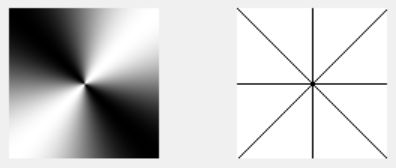Example 2
So far so good. We first continue with another standard textbook example.
$$
G(x,y) = \left\{ \begin{array}{ll}
2 x y/(x^2 + y^2) & \quad \mbox{for} \quad (x,y) \ne (0,0) \\
0 & \quad \mbox{for} \quad (x,y) = (0,0)
\end{array} \right.
$$
Proceeding again with some - innocent looking - iterated limits:
$$
\lim_{x\rightarrow\infty} \left( \lim_{y\rightarrow\infty}
\frac{2 x y}{x^2 + y^2} \right) =
\lim_{\rightarrow\infty} \left( \lim_{y\rightarrow\infty}
\frac{2 x/y}{x^2/y^2 + 1} \right) =
\lim_{x\rightarrow\infty} (0) = 0
$$ $$
\lim_{y\rightarrow\infty} \left( \lim_{x\rightarrow\infty}
\frac{2 x y}{x^2 + y^2} \right) =
\lim_{y\rightarrow\infty} \left( \lim_{x\rightarrow\infty}
\frac{2 y/x}{1 + y^2/x^2} \right) =
\lim_{x\rightarrow\infty} (0) = 0
$$
The iterated limits, apparently, commute.
$$
\lim_{x\rightarrow 0} \left( \lim_{y\rightarrow 0}
\frac{2 x y}{x^2 + y^2} \right) =
\lim_{x\rightarrow 0} \left( \lim_{y\rightarrow 0}
\frac{2 y/x}{1 + y^2/x^2} \right) =
\lim_{x\rightarrow 0} \left( \frac{0}{1} \right) = 0
$$ $$
\lim_{y\rightarrow 0} \left( \lim_{x\rightarrow 0}
\frac{2 x y}{x^2 + y^2} \right) =
\lim_{y\rightarrow 0} \left( \lim_{x\rightarrow 0}
\frac{2 x/y}{x^2/y^2 + 1} \right) =
\lim_{y\rightarrow 0} \left( \frac{0}{1} \right) = 0
$$
The iterated limits, apparently, commute. But it's good to take a closer look
at the above. We will do so by introducing polar coordinates:
$$
x = r\cos(\phi) \SP y = r\sin(\phi)
$$
Giving:
$$
G(x,y) = \frac{2 x y}{x^2 + y^2} =
\frac{r^2 . 2 \cos(\phi)\sin(\phi) }
{r^2 ( \cos^2(\phi) + \sin^2(\phi) ) } = \sin(2\phi)
$$
Unlike what one might expect, the function $G(x,y)$ doesn't behave much neater
than than function $F(x,y)$ in the previous example.
The iterated limits for $x$ and $y$ do indeed commute, but such is more or less
a coincidence. In fact, the function $G(x,y)$ is like the function $F(x,y)$ but
rotated over an angle of $45^o$ (counterclockwise), because
$\sin 2 \phi = \cos 2 (\phi-\pi/4)$:

A "natural" way to define limits with the function $G(x,y)$ is to proceed along
contour lines. Just suppose that we decide to approach the origin as well as
infinity along a single contour line. What we have then are single limits.
So let's repeat the limit for $G(x,y)$ while assuming that $y=-x$. The latter
is a "black" contour line extending to infinity and to zero. Then we get:
$$
\lim_{(x,y)\rightarrow(0,0)} \frac{2 x y}{x^2 + y^2}
= \lim_{x\rightarrow 0} \frac{-2 x^2}{2 x^2} = -1
$$ $$
\lim_{(x,y)\rightarrow(\infty,\infty)} \frac{2 x y}{x^2 + y^2}
= \lim_{x\rightarrow \infty} \frac{-2 x^2}{2 x^2} = -1
$$
Repeat the limit for $G(x,y)$ while assuming that $y=+x$, a "white" contour
line extending to infinity and to zero. Then we get:
$$
\lim_{(x,y)\rightarrow(0,0)} \frac{2 x y}{x^2 + y^2}
= \lim_{x\rightarrow 0} \frac{2 x^2}{2 x^2} = +1
$$ $$
\lim_{(x,y)\rightarrow(\infty,\infty)} \frac{2 x y}{x^2 + y^2}
= \lim_{x\rightarrow \infty} \frac{2 x^2}{2 x^2} = +1
$$
These outcomes are to be expected, because the function $G(x,y)$ is like the
function $F(x,y)$ as described above, apart from a rotation of the coordinate
system. Indeed, we have seen the following.
Select a contour line in the "black" region of $F(x,y)$, namely $x = 0$ . Then:
$$
\lim_{(x,y)\rightarrow(0,0)} \frac{x^2 - y^2}{x^2 + y^2} =
\lim_{y\rightarrow 0} \frac{-y^2}{y^2} = -1
$$ $$
\lim_{(x,y)\rightarrow(\infty,\infty)} \frac{x^2 - y^2}{x^2 + y^2} =
\lim_{y\rightarrow \infty} \frac{-y^2}{y^2} = -1
$$
Select a contour line in the "white" region of $F(x,y)$, namely $y = 0$ . Then:
$$
\lim_{(x,y)\rightarrow(0,0)} \frac{x^2 - y^2}{x^2 + y^2} =
\lim_{x\rightarrow 0} \frac{x^2}{x^2} = +1
$$ $$
\lim_{(x,y)\rightarrow(\infty,\infty)} \frac{x^2 - y^2}{x^2 + y^2} =
\lim_{x\rightarrow \infty} \frac{x^2}{x^2} = +1
$$
Therefore attention can be restricted to $F(x,y)$, without missing anything.
With $F(x,y)$, the function values vary between $-1$ and $+1$, meaning that limits
like the above, without further specification (e.g. along a contour line),
actually do not exist for $G(x,y)$ as well:
$$
\lim_{(x,y)\rightarrow(0,0)} \frac{2 x y}{x^2 + y^2} = \mbox{undefined}
$$ $$
\lim_{(x,y)\rightarrow(\infty,\infty)} \frac{2 x y}{x^2 + y^2} =
\mbox{undefined}
$$

